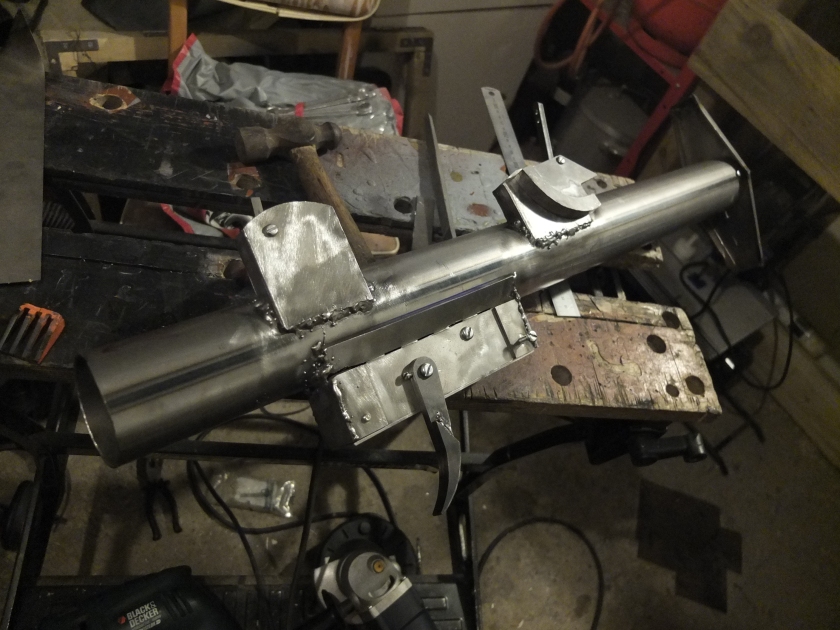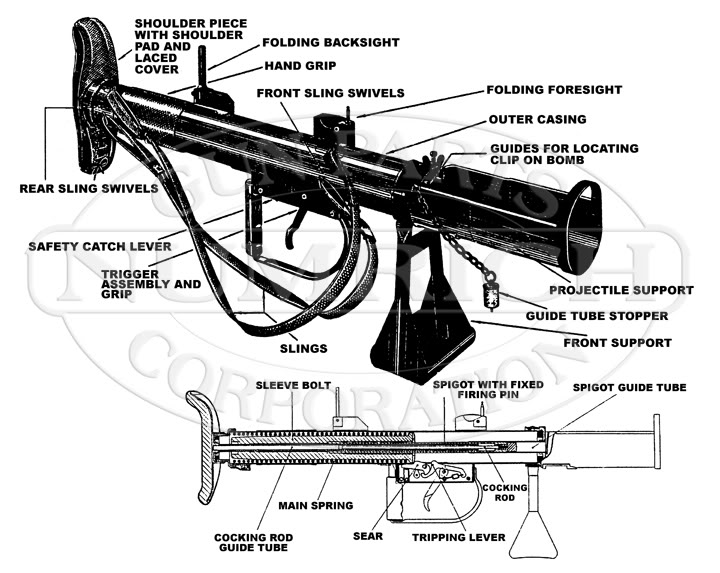Using CAD has started to become a bit of a habit… The PIAT was no exception!
I wanted to use a massive spring in this, even though there are more practical ways of firing a shell it’s true to the original and has some serious man-points attached!

This is actually my second design, my initial design was slightly different internally and used the direct power of the spring to drive the projectile. Although this worked in my initial experiments, once I made the piston captive (necessary to stop half a kilo of steel from smacking someone in the face) the ball barely fired. The redesign will use a CO2 shell or blank-firing mechanism depending on use.

The buttplate is 2mm folded steel, welded into place purely for aesthetic reasons, as the original was stamped steel. Once polished up that is how it will look.
Sight units next: foresight and rear sight are different shapes but much the same idea. I fitted them together before welding so that they would line up correctly.


With these two units complete, I could make the trigger mechanism. This is my version one, I have since then made some refinements that will make it smoother to use.

One spring resets the second sear. You can see in this photograph that the spring pushes the sear up very high, this ended up being a problem as the force of the mainspring would make it almost impossible to actuate the mechanism. The next version fixes this by keeping the second sear at a usable height against the piston.

All welded in place, ready to be cleaned up.

Testing rig prior to making the piston captive. I also ended up making lightening cuts to the piston to improve travel speed. You can see the size of the spring in this shot, at one point I was unfortunate enough to be in the way of the piston when the sear slipped and it gave me a smart upper-cut to the chin. Fortunately it was only at half-cock otherwise I would have been in a pretty bad way!

So, I’ll admit I have skipped a bit ahead here but the back end of the launcher was pretty well finished at this stage except for some adjustments to be made just before completion. Like the original, re-cocking is achieved by standing on the buttplate and lifting the rest of the launcher. I set to work on the fore-end that would hold the projectile.
This is a spare piece of mild steel tube I had left over from a previous build. I marked out the cutout on the top and removed it with an angle grinder.

I then cut out a steel disk for the back of the head, drilling the centre for the ‘spigot’ (the steel rod that in the real version would fire the explosive charge in the shell) to come out of. This could then be welded in place along with the collar that attaches the head to the body. Five screws distributed around the circumference hold it in place.
As well as the mainspring, at this point I added a smaller spring that sits around the spigot to absorb the shock of the piston finishing its travel. This spring just bounces freely off the back of the head.
As I said at the start, this is the point where testing became less successful. Without the weight of the piston carrying the tennis balls I was firing originally they only just left the barrel. As a result, the design is being modified to take CO2 grenades. In the longer run it will also be able to fire blanks for re-enactment purposes.
If you are interested in this build, have any questions or would like a build of your own, let me know! Our email is: enquiries.vintageairsoft@gmail.com or you can contact us through our Facebook page!


 The trigger mechanism is now also smaller and smoother to operate, so it now looks like this:
The trigger mechanism is now also smaller and smoother to operate, so it now looks like this:
















